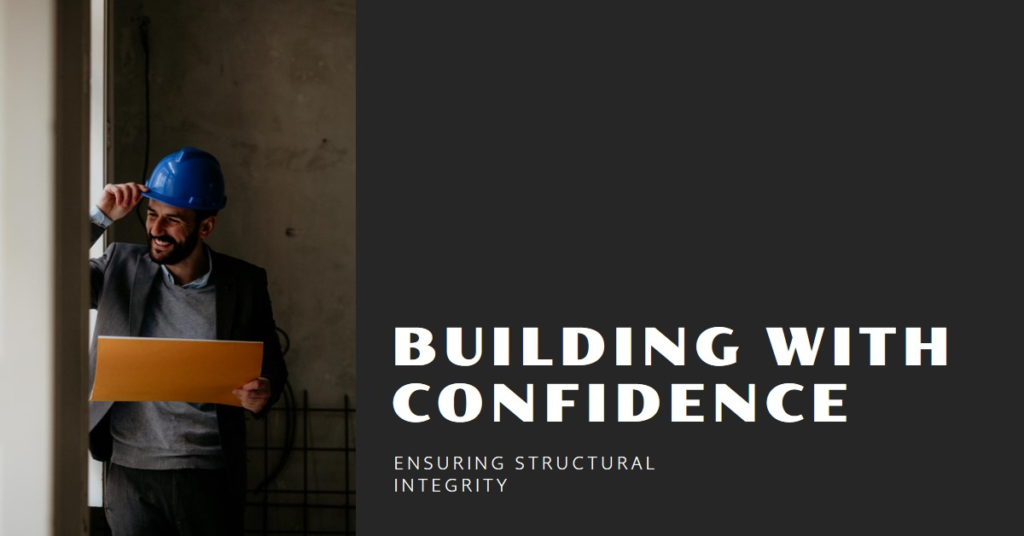
Table of Contents
Introduction to Structural Integrity:
Structural Integrity – Building with confidence is more than just a catchphrase; it’s a fundamental principle that underpins the construction industry. Every building, whether it’s a towering skyscraper or a humble family home, relies on solid structural integrity to withstand the test of time. In this blog post, we delve into the key considerations and strategies for ensuring structural integrity in building projects. From foundation to finish, each stage plays a crucial role in constructing with confidence.
Understanding Structural Integrity:
At the heart of every successful building project lies the concept of structural integrity. It encompasses the ability of a structure to withstand its intended loads and environments over time without experiencing failure. Achieving structural integrity requires a meticulous approach from conception to completion. Architects, engineers, and builders must collaborate closely to ensure that every aspect of the design and construction meets stringent standards.
The Importance of Quality Materials:
One of the cornerstones of building with confidence is the use of high-quality materials. From reinforced concrete to steel beams, the materials selected for a construction project directly impact its structural integrity. Cutting corners on materials may result in compromised durability and safety. Therefore, it’s imperative to prioritize the use of reputable suppliers and materials that meet or exceed industry standards. Investing in quality materials upfront can mitigate risks and contribute to the long-term viability of the structure.
Robust Foundation Systems:
A strong foundation is the backbone of any building. Without a solid base, the entire structure is at risk of instability and structural failure. Building with confidence starts from the ground up, with careful consideration given to foundation design and construction. Whether it’s shallow foundations for low-rise structures or deep foundations for high-rise buildings, the chosen system must be engineered to withstand the unique challenges of the site.
Engineering Excellence in Design:
The design phase of a building project lays the groundwork for its structural integrity. Engineers employ advanced techniques and technologies to model and analyze the behavior of the structure under various conditions. Through meticulous planning and calculation, they ensure that the building can withstand loads such as gravity, wind, seismic activity, and environmental factors. Engineering excellence in design is essential for building with confidence, as it provides the blueprint for a safe and resilient structure.
Precision in Construction Techniques:
Construction is where the theoretical meets the practical, and precision is paramount. Skilled labor, modern equipment, and adherence to best practices are essential for executing the design with accuracy and efficiency. From laying bricks to erecting steel frames, every aspect of the construction process must be carried out with care and attention to detail. Deviations from the plans or shortcuts in construction techniques can compromise the structural integrity of the building.


Adherence to Building Codes and Regulations:
Building codes and regulations serve as the framework for ensuring structural integrity and safety in construction projects. They establish minimum standards for design, materials, construction methods, and occupancy. Adhering to these codes is non-negotiable for builders and developers. Compliance not only protects the occupants and the public but also safeguards against potential legal liabilities. Building with confidence means going above and beyond the minimum requirements to prioritize safety and quality.
Continuous Quality Assurance:
Quality assurance is an ongoing process that permeates every stage of a building project. From the initial site preparation to the final walkthrough, vigilant oversight is essential to identify and rectify any deviations or deficiencies. Inspections, testing, and monitoring help ensure that the completed structure meets or exceeds the specified standards. By maintaining a focus on quality assurance, builders can instill confidence in the integrity of their work.
Investing in Long-Term Maintenance:
Building with confidence doesn’t end when the construction crews pack up and leave. Long-term maintenance is a critical aspect of preserving structural integrity and extending the lifespan of a building. Regular inspections, proactive repairs, and preventative maintenance measures are essential for addressing wear and tear, environmental degradation, and other factors that can compromise the structure over time. Investing in a comprehensive maintenance plan from the outset demonstrates a commitment to sustainability and durability.
Conclusion:
Ensuring structural integrity is the bedrock of building with confidence. From the foundation to the finishing touches, every aspect of the construction process must be approached with precision, care, and adherence to best practices. By prioritizing quality materials, robust design, and continuous oversight, builders can create structures that stand the test of time and inspire confidence in all who inhabit them. Building with confidence isn’t just about erecting buildings; it’s about creating spaces that endure and enrich the lives of generations to come.


